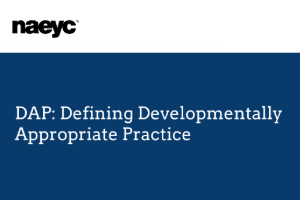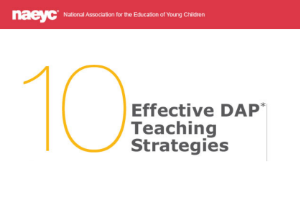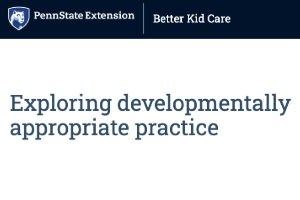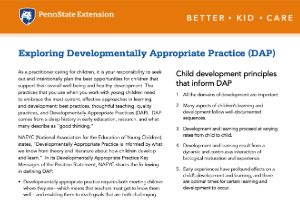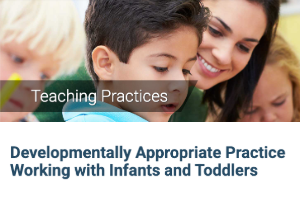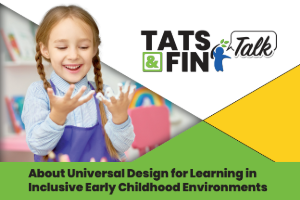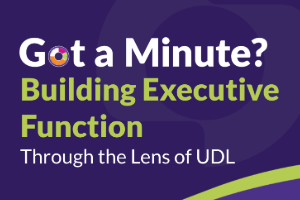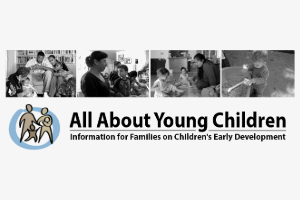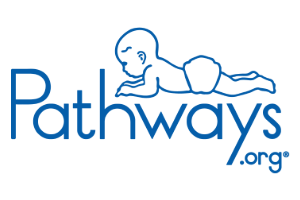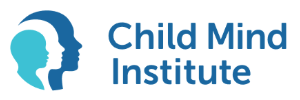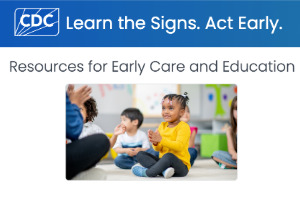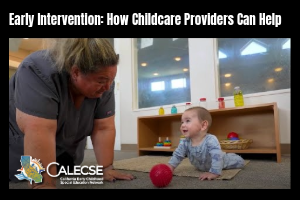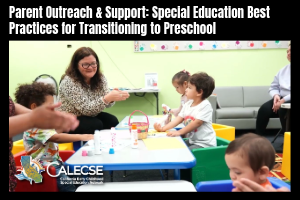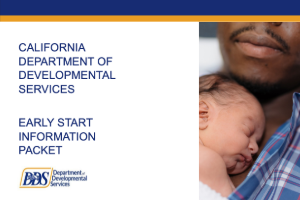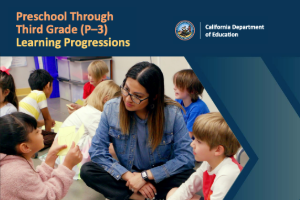Back to School Refresher: Developmentally Appropriate Practice, Universal Design for Learning, and Child Development Resources!
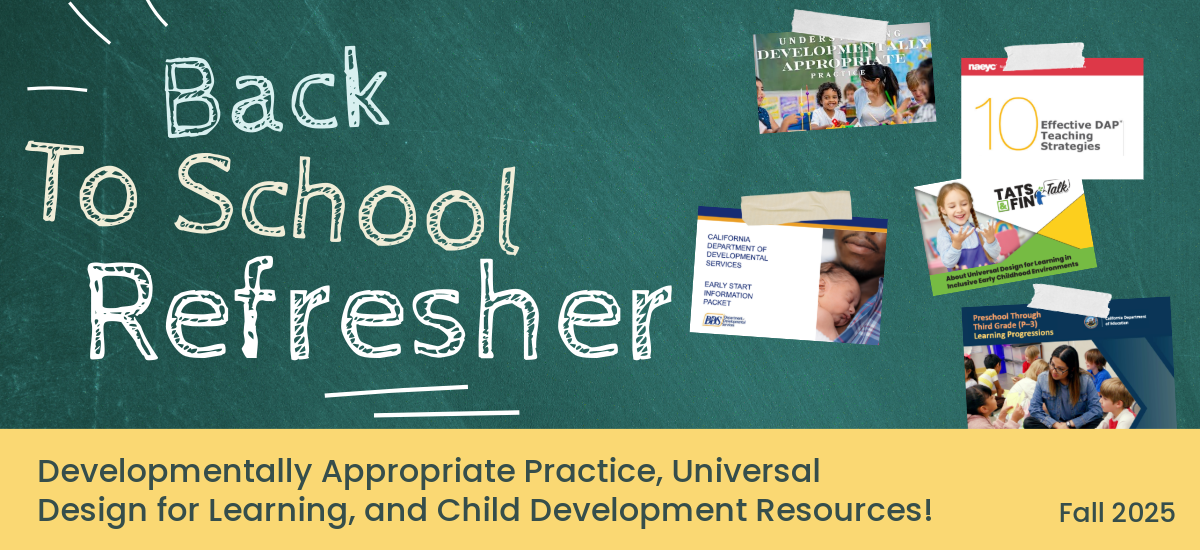
Preschools and early care and education programs are often serving younger children as many four-year-old children are attending programs like Transitional Kindergarten (TK). Curriculum and routines may need to be adjusted to meet the needs of younger children and children with diverse learning styles. Preschool and TK teachers may be transitioning from teaching elementary school aged children to preschool aged children and may need additional knowledge and support for teaching younger children.
The California Making Access Possible (MAP) offers a few key resources on Developmentally Appropriate Practice (DAP), Universal Design for Learning (UDL), and child development to support early care and education providers and teachers in meeting the learning needs of all children including children who may be identified with a developmental delay.
Developmentally Appropriate Practice and Universal Design for Learning
Developmentally Appropriate Practice (DAP) and Universal Design for Learning (UDL) are frameworks that support inclusive and effective education for all learners, particularly in early childhood settings. DAP focuses on tailoring teaching to each child’s developmental stage, while UDL provides flexible approaches to learning and assessment. Both frameworks emphasize creating supportive, engaging, and accessible learning environments. The resources below include a position statement on DAP along with tip sheets and videos and an article from Head Start. UDL resources include a tip sheet, and resources from the California Coalition for Inclusive Learning on UDL.
DAP: Defining Developmentally Appropriate Practice – NAEYC Position Statement
Chief among the professional responsibilities of early childhood educators is the responsibility to plan and implement intentional, developmentally appropriate learning experiences that promote the social and emotional development, physical development and health, cognitive development, and general learning competencies of each child served.1 But what does it mean to be “developmentally appropriate”? The NAEYC position statement defines the term. The definition emerges from a set of evidence-based core considerations and principles of child development and learning, all of which are explained in the principles section of this statement. Further understanding comes from the following guidelines that address decisions that early childhood professionals make in six key and interrelated areas of practice: (1) creating a caring community of learners; (2) engaging in reciprocal partnerships with families and fostering community connections; (3) observing, documenting and assessing children’s development and learning; (4) teaching to enhance each child’s development and learning; (5) planning and implementing an engaging curriculum to achieve meaningful goals; and (6) demonstrating professionalism as an early childhood educator. Visit the NAEYC Position Statement website for more information.
Joyful Learning DAP (Video)
NAEYC experts Susan Friedman and Alissa Mwenelupembe present on the importance of understanding Developmentally Appropriate Practice: Children are born eager to learn but not all settings support joyful learning. Responsive relationships are key. How educators encourage educational/social/emotional well-being is what Developmentally Appropriate Practice (DAP) is all about. But children from under-resourced communities (many BIPOC) have less access to engaged joyful learning, contributing to the opportunity gap.
Understanding Developmentally Appropriate Practice (Video)
Developmentally Appropriate Practice (DAP) is an educational framework designed to promote young children’s optimal learning and development. Learn more about DAP in this video. This book is a summary of the work of Carol Copple, Janet Gonzalez-Mena, and Sue Bredekamp.
10 Effective DAP Teaching Strategies
An effective teacher or family child care provider chooses a strategy to fit a particular situation. It’s important to consider what the children already know and can do and the learning goals for the specific situation. By remaining flexible and observant, we can determine which strategy may be most effective. Often, if one strategy doesn’t work, another will. This article describes each strategy and gives you access to a downloadable infographic with all 10 strategies. Download it and laminate it for regular use! (PDF)
Exploring Developmentally Appropriate Practice
“Developmentally appropriate practice requires both meeting children where they are—which means that teachers must get to know them well —and enabling them to reach goals that are both challenging and achievable.”
As a practitioner caring for children, it is your responsibility to seek out and intentionally plan the best opportunities for children that support their over-all well being and healthy development. The practices that you use when working with young children need to embrace the most current, effective approaches in learning and development. These can be described as best practices, thoughtful teaching, quality practices, or Developmentally Appropriate Practices (DAP). DAP comes from a deep history in early education, research, and what many describe as “good thinking.”
This Tip Sheet on Child Development Principles and DAP Decision-Making Tool (PDF) from Better Kid Care of PennState Extension lays out key messages from the NAEYC Position Statement, lists the child development principles that inform DAP, provides a brief decision-making tool to help guide in your implementation of DAP.
Tip Sheet: Child Development Principles and DAP Decision-Making Tool (PDF)
“Developmentally appropriate practice requires both meeting children where they are—which means that teachers must get to know them well —and enabling them to reach goals that are both challenging and achievable.”
Developmentally Appropriate Practice Working with Infants and Toddlers
This “News You Can Use” explores the meaning behind developmentally appropriate practice and working with infants and toddlers. The real-life scenarios from Head Start are informative and provide a closer look at the foundational role relationships play in developmentally appropriate practice.
Universal Design for Learning in Early Care and Education Environments
DAP encourages the use of Universal Design for Learning principles and practices to help create caring communities of learners and to teach to enhance children’s learning. Educators can plan, teach, and assess through multiple modes, strategies, and materials within everyday routines and activities. In collaboration with colleagues and families, effective educators “see that each child gets the adaptations and specialized services needed for full inclusion as a member of the community and that no child is penalized for their ability status.” – NAEYC, Individuality and Inclusive Practices for Early Childhood, Young Children, 2021, Vol. 76, No. 4
Tip Sheet on UDL: About Universal Design for Learning in Inclusive Early Childhood Environments (PDF)
UDL is a framework for intentionally, proactively, and reflectively addressing the learning needs of diverse and exceptional learners in the classroom (CAST, 2018). It contains principles that guide the selection of curriculum materials and resources that all children can use, providing support for diverse abilities, learning preferences, languages, and cultural backgrounds.
This tip sheet is perfect for printing and making available in the staff break room or bulletin board!
California Coalition for Inclusive Learning (CCIL)
The California Coalition for Inclusive Learning (CCIL) , funded by the California Department of Education, offers resources for educators in a variety of roles to support their practice in universally designing learning experiences for all learners. In anticipation of the barrier of time, they have designed three ways to engage on a particular topic: Webinars, Top Tips!, and Got a Minute? Learning Series.
The Early Childhood Education web page includes a variety of ways to engage in learning about UDL.
Under Got a Minute you can determine how much time you want to spend on learning about UDL and choose a format: either a set of google slides for group learning or an online course.
Early Childhood through the lens of UDL is a webinar for the seasoned educator looking to enhance your inclusive teaching practices or a newcomer seeking guidance on creating accessible learning environments, this webinar offers valuable insights and resources to support your journey.
Visit the UDL in Action page to see videos that demonstrate UDL for all ages from early childhood through high school.
CAST is a nonprofit education research and development organization best known for creating the Universal Design for Learning (UDL) framework and Guidelines—tools now used around the world to design more inclusive and flexible learning environments.
The California Coalition for Inclusive Learning (CCIL) is a collaborative partnership between CAST and six county offices of education across California. Visit the website to learn more.
Child Development Resources
To gain a greater understanding of the skills and behaviors that you can expect across developmental domains in children from birth to age six, explore the resources on these websites according to your interests. Descriptions of the unique features of each website are bolded. Also included in the Child Mind website and the CDC Learn the Signs Act Early websites are videos and articles that help you identify and share concerns about development.
All About Young Children: Information for Families on Children’s Early Development
As a parent, you are your child’s first teacher. You have experienced how fascinating and how puzzling your young child can sometimes be. We invite you to explore with us information that can help you understand your child’s learning and discover new ways to support your growing child.
Articles and videos in multiple languages explain what can be expected in various developmental domains for various ages of children.
Pathways.org
Since 1985, Pathways.org has helped parents and healthcare professionals work together to maximize babies’ development. For over 40 years, we have provided free and trusted resources to identify early motor, sensory, communication, and feeding delays while also offering information to help all babies.
With a focus is on infants and toddlers, the website includes milestones by age group and developmental domain, video examples, checklists, helpful articles about early intervention, social-emotional skills, play, activities for each age group and more. It also provides a library of videos with parenting information and activities for each age group.
Complete Guide to Developmental Milestones
Every child is different, and so is every parent’s experience; but experts have a clear idea about the range of normal development from birth to age 5 — and signs that a child might have a developmental delay. Below you’ll find milestones organized by period of development, and tips on when to contact a health professional about your concerns. Remember — there is no penalty for being cautious about your growing child, and if there is a problem acting early can make all the difference.
The information available in English and Spanish. It also includes “developmental health watch” descriptions to alert you to behaviors that may indicate a developmental delay.
Developmental Milestone Resources for Early Care and Education Programs
- Provides professional development with the free 4 module Watch Me! Celebrating Milestones and Sharing Concerns training module (updated in 2024 and includes opportunity to gain CEU’s).
- Guides providers in sharing information and resources with families
- Gives access to free materials to share with families and a downloadable milestone poster. Most materials are in English and Spanish
- Tips for Talking with Parents About Developmental Concerns (PDF)
This tip sheet reinforces the messages in the MAP PowerPoint, Talking to Parents When You Have Concerns About a Child in Your Care
California Resources Supporting Early Identification
Early care and education providers are frequently the first to notice differences in development based on their knowledge of development and experience with children. MAP to Inclusion and Belonging offers resources to support providers in talking to families about concerns and helping them find the resources they need to support their children. California Early Childhood Special Education (CalECSE) has created videos around this topic. One describes the role of early care and education professionals can help with early intervention and the other describes how Family Resource Centers can help families. The California Department of Developmental Services offers an information packet that describes the services of the Regional Centers. Early care and education providers should be aware of the packet and the services.
MAP Resources
Talking to Parents When You Have Concerns About a Child in Your Care
This PowerPoint™ and accompanying article is designed to provide a framework for caregivers (anyone providing child care or out-of-school care for children) when they have concerns that a child in their care might have a developmental delay, disability, or significant behavior problem; when preparing to share concerns with a child’s parents or family members (anyone raising the child); or in understanding different ways family members will receive and act on an expressed concern. Available in English, Spanish and Chinese.
County Specific Resources: Organizations that Support Children with Disabilities and Their Families
Organizations supporting children with disabilities and inclusion/behavior resources in each county are found here. Included are Regional Centers, Early Start Family Resource Centers, Child Care Resource and Referral Agencies and more!
Early Identification
See the Early Identification Guide that describes the key elements of early identification and Developmental Screening. It includes a Spanish translation.
Videos from California Early Childhood Special Education (CalECSE)
Early Intervention: How Childcare Providers Can Help (Video)
Childcare providers throughout California can play a vital role in identifying potential developmental delays in the children they care for at an early stage, thereby ensuring those children can receive resources and support as soon as possible. In this video, we look at the importance of early identification and signs to look out for, resources that exist for parents, and how childcare providers can help parents access those resources.
Parent Outreach & Support: Special Education Best Practices for Transitioning to Preschool
Did you know that every Regional Center throughout California has a Family Resource Center (FRC)? These FRCs work in partnership with the Regional Centers and LEAs and provide parents, families and children with information and resources regarding early intervention services. In this video, the San Gabriel Pomona Parents’ Place Family Resource & Empowerment Center highlights how FRCs support families as their children enter early childhood education and prepare for school-aged programs, empowering them to becoming active partners in the process.
California Department of Developmental Services Resources
California Early Start Information Packet
This Early Start Standardized Information Packet is for Children Aged 0-3
In California, early intervention services are offered by the Department of Developmental Services (DDS) through a program called Early Start. This program is designed for infants and toddlers who have developmental delays or are at risk for developmental disabilities. Early help can greatly benefit a child’s growth and may lessen the support they need later on.
Just Released California Department of Education Resource: Preschool Through Third Grade Learning Progressions
P-3 Learning Progressions
The California Department of Education (CDE) released the Preschool Through Third Grade (P-3) Learning Progressions on August 14, 2025. The learning progressions are designed to strengthen alignment and coherence across preschool to third grade. They are now available on the CDE P-3 Alignment web page.
Educators and administrators in early education can use the P-3 Learning Progressions to support developmentally appropriate, joyful learning and seamless transitions from preschool through third grade.
This resource includes the knowledge and skills children develop over the P-3 continuum and in practice examples that illustrate how educators can use playful, inquiry-based teaching practices to engage children in developmentally appropriate learning experiences.

